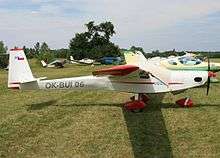TeST TST-5 Variant
The TeST TST-5 Variant is a Czech homebuilt aircraft that was designed and produced by TeST Gliders of Brno, introduced c. 1998. When it was available the aircraft was supplied as a completely assembled aircraft, without engine or instruments, and also as a kit for amateur construction.[1]
| TST-5 Variant | |
|---|---|
 | |
| TST-5 Variant Duo | |
| Role | Homebuilt aircraft |
| National origin | Czech Republic |
| Manufacturer | TeST Gliders |
| Introduction | circa 1998 |
| Status | Production completed |
| Unit cost |
US$16,950 (complete, less engine and instruments, 1998) |
Design and development
The TST-5 Variant features a strut-braced shoulder-wing, a two-seats-in-side-by-side configuration enclosed cockpit under a bubble canopy, fixed tricycle landing gear with wheel pants and a single engine in tractor configuration.[1]
The aircraft is of all-wood construction. Its constant-chord wing with a NACA 4415 airfoil is intended to give docile handling and is supported by "V"-struts. The standard engine used is the M-125 powerplant.[1][2]
The manufacturer estimated the construction time from the supplied "express-built" kit as 250 hours.[1]
Variants
Specifications (TST-5 Variant)

Data from AeroCrafter and The Incomplete Guide to Airfoil Usage[1][2], Jane's all the World's Aircraft 2004–05[3]
General characteristics
- Crew: one
- Capacity: one passenger
- Length: 6.4 m (21 ft 0 in)
- Wingspan: 10.5 m (34 ft 5 in)
- Height: 2.3 m (7 ft 7 in)
- Wing area: 13.7 m2 (147 sq ft)
- Aspect ratio: 8
- Airfoil: NACA 4415
- Empty weight: 260 kg (573 lb)
- Max takeoff weight: 450 kg (992 lb)
- Fuel capacity: 36 l (9.5 US gal; 7.9 imp gal)
- Powerplant: 1 × Rotax 582 UL 2-cylinder 2-stroke liquid-cooled piston engine, 47.8 kW (64.1 hp)
- Propellers: 2-bladed fixed pitch propeller
Performance
- Cruise speed: 150 km/h (93 mph, 81 kn) max; 90–120 km/h (56–75 mph; 49–65 kn) economical
- Stall speed: 65 km/h (40 mph, 35 kn)
- Never exceed speed: 170 km/h (110 mph, 92 kn)
- Service ceiling: 4,000 m (13,000 ft)
- g limits: +4 / -2
- Rate of climb: 3.5 m/s (690 ft/min)
References
- Purdy, Don: AeroCrafter - Homebuilt Aircraft Sourcebook, Fifth Edition, page 362. BAI Communications, 15 July 1998. ISBN 0-9636409-4-1
- Lednicer, David (2010). "The Incomplete Guide to Airfoil Usage". Retrieved 11 May 2014.
- Jackson, Paul, MRAeS, ed. (2005). Jane's all the World's Aircraft 2004–05. London: Janes Publishing Group. p. 116. ISBN 0-7106-2614-2. Italic or bold markup not allowed in:
|publisher=(help)
External links
| Wikimedia Commons has media related to TeST TST-5. |